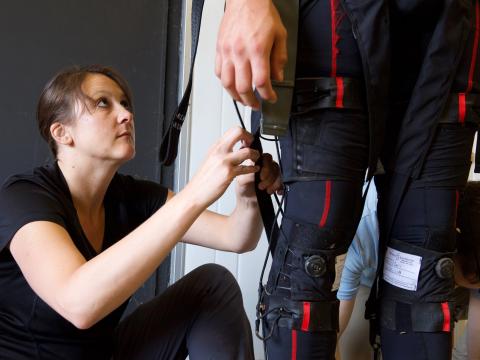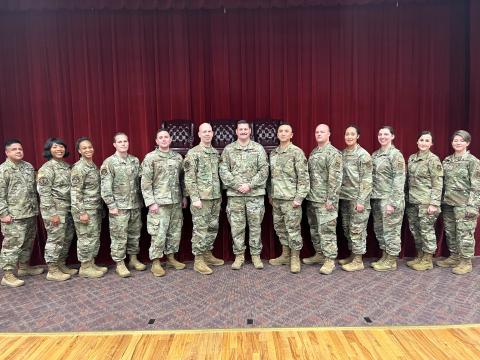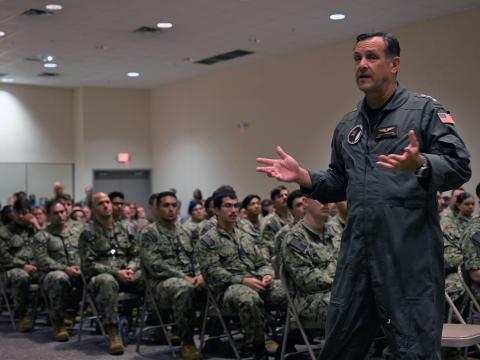Handshakes on the High Seas
A Salvadoran sailor rides a U.S. Navy boat near the High Speed Vessel (HSV) 2 Swift during a boarding team officer and visit, board, search and seizure subject matter expert exchange for Southern Partnership Station (SPS) 2010. The SPS is a deployment of various specialty platforms to the U.S. Southern Command area of responsibility in the Caribbean and Latin America.
Navy program aims to solidify peace and partnerships to protect the maritime environment south of the 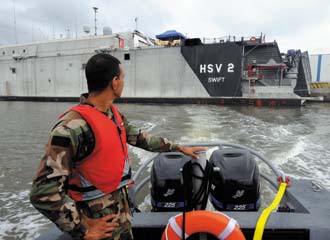
The U.S. Navy is investing significant time and effort to secure the waters that surround Latin America and the
Southern Partnership Station (SPS) 2010 marked the fourth year that sailors boarded specialty platforms and set off across the ocean to work with counterparts in nations that fall under the U.S. Southern Command’s (SOUTHCOM’s) area of responsibility. U.S. Fleet Forces Command initially directs the various resources for SPS based on current requirements. Once the resources are in the SOUTHCOM area of operations, the U.S. Fourth Fleet, which exercises operational control of assigned forces in that region, manages them. The commander of the Fourth Fleet is dual-hatted, also serving as the commander of the U.S. Naval Forces Southern Command (NAVSO), which helps to coordinate the event each year.
The platforms this year include High Speed Vessel (HSV), Oceanographic, Navy Diver and Amphibious. Each platform visits various ports to perform its own specific training and information-exchange roles. The missions include activities such as martial arts, leadership, land navigation, marksmanship, port security, boarding officer and teams, joint military surveys, oceanographic, hydrographic, bathymetric and technical demonstrations. Part of each trip also involves spending enough time in port to assist local communities that want help through activities such as making repairs to an orphanage. As part of the relationship building and outreach efforts,
The first version of SPS took place in 2007 and was the pilot for the Global Fleet Station (GFS) concept, a maritime security cooperation initiative aimed at strengthening global partnerships through training and cooperation activities. The activity that year involved only one platform, the HSV 2 Swift, and was called the GFS. Now, SPS is SOUTHCOM’s name for the GFS. The concept fits in well with aims of SOUTHCOM to build relationships with the nations in its region through dialogue, interaction and idea exchange. The GFS is not limited to nations in Latin America and the
Cmdr. Timothy Veschio, USN, who works in the Fourth Fleet/NAVSO Future Plans office, plans the HSV missions and co-plans the oceanographic missions. In the latter, the countries’ oceanographic personnel sail together to survey coastlines and perform topographic functions. For one exercise this year,
The Swift served as the HSV platform again during this year’s exercise, taking advantage of partnerships with the private sector. Civilian contract mariners working for a company under charter to the Navy’s Military Sealift Command operate and navigate the vessel. A Marine Corps Training and Advisory Group (MCTAG) also deployed with the Swift to engage in partnering with other countries’ marines. A MCTAG consists of approximately seven Marines led by an officer. In 2010, the Swift was scheduled to visit
In some situations, the
The choice of the Swift as the HSV platform has several purposes in addition to its speed. “It’s kind of iconic,” Cmdr. Veschio says. The notable look of the large gray catamaran sitting up out of the water with its sharply angled front pointing into the distance catches the interest of partner nations and makes it easily recognizable. It also is designed with plenty of storage room—the commander describes it with the word “ferry”—so sailors can transport goods and equipment to their different ports of call.
A U.S. Navy diver and Regional Security System divers conduct a visual inspection of a mooring buoy off the coast of Antigua as part of SPS 2010.
One program taking advantage of that cargo space is Project Handclasp, a Navy effort with a civilian component that delivers donated materials to countries that can use them. Though the project operates in many places around the globe, it takes advantage of the partnership building of the SPS to further its cause. Each year, Project Handclasp uses the extra space aboard the SPS platforms to transport its supplies to various locations in 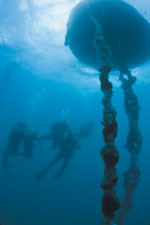
The project takes the idea of relationship building beyond military-to-military or even government-to-government engagement. Private organizations and public agencies donate the new or used materials to Project Handclasp, which then employs Navy assets to move them to countries that need assistance. A civilian board of directors helps to solicit donations. According to Cmdr. Lewis Preddy, USN, the coordinator for Project Handclasp at Fourth Fleet, multiple platforms are participating in this work. The offerings add to the main objective of information exchange between regional partners. “Gifts in kind are always a secondary mission,” Cmdr. Preddy says.
These gifts take many forms from basics, such as medical supplies, to the unexpected. “It kind of runs the gamut of stuff,” the commander explains. A June drop-off involved an out-of-the-ordinary donation when SPS sailors delivered two fire trucks to
Sometimes after a deployment, project personnel learn of other items that are needed, and they try to accommodate those needs in the future. In certain cases, requested items are expensive and difficult to come by, such as a portable hyperbaric chamber. But, Cmdr. Preddy explains, people in the
He believes that the SPS not only benefits Project Handclasp, but also makes a big impact overall. “I wish I’d designed the program,” Cmdr. Preddy says, adding that, “We love doing these SPS missions.” He describes the SPS as an excellent chance to build relationships over a period of years and to establish familiarity among members of different armed forces as they train side by side. Though he admits that politics is involved in everything, he says the SPS is not interested in politics. Instead, the focus is on creating friendships.
In 2010, those strong relationships came into play in more than an exercise or information-exchange environment. When an earthquake struck
One of those vessels was the last Navy ship to depart
The Amphibious platform the USS New Orleans also supported an exercise during its deployment. The ship and her sailors traveled to
Though the SPS is largely a Navy effort, programs and personnel are not restricted to the sea service or the Marine Corps. The Navy works with the other military branches as appropriate to carry out its objectives. The Grasp, for example, hosted Army divers during its first few months of the SPS. In the past, Air Force foreign area officers provided language and culture expertise. Interpreters from other services also have participated in the SPS. Cmdr. Veschio says next year the station might include Army veterinarians or medical specialists. Aspects of the SPS also work with country teams and embassies to coordinate activities.
WEB RESOURCES
NAVSO/Fourth Fleet: www.public.navy.mil/comusnavso-c4f/Pages/default.aspx
Regional Security System: www.rss.org.bb
